#joseph i zu schwarzenberg
Text
Speaking of the hunt, I would love to share one more Schwarzenberg-related story before I go on a small break, tied to the New Year celebrations which are incredibly festive in Russia. :)
This time it will be about grand-grand-parents of field marshal Schwarzenberg: Adam Franz zu Schwarzenberg (1680 - 1732) and Eleonore von Schwarzenberg (nee Lobkowicz) (1682 - 1741). Next to Eleonore you can see a little boy: that’s actually Karl’s grand-father Joseph I zu Schwarzenberg (in whose honour his elder brother was named) (1722 - 1782).
Since I promised to speak more about one particular topic, you can already guess: field marshal’s grand-grand-parents were incredibly passionate hunters (I guess, it actually ran in Karl’s blood)! In the paintings presented below you can see Eleonore in her illustrious attire holding a hunting rifle while her husband Adam wears the ceremonial robes of the Order of the Golden Fleece. 🎖
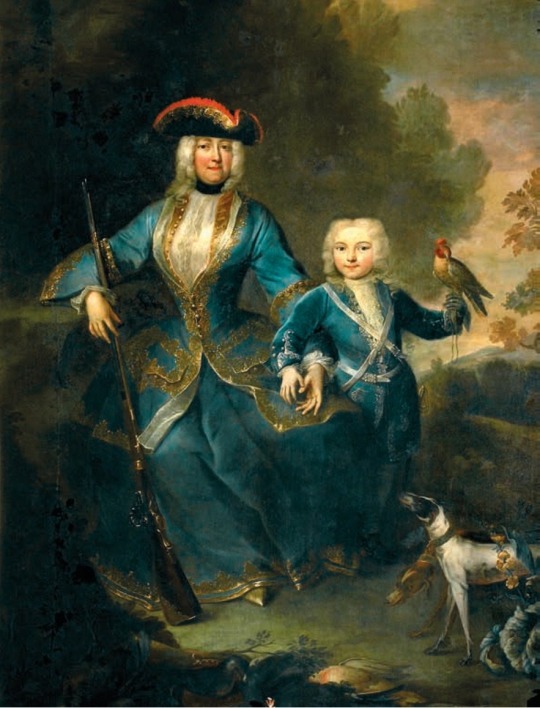
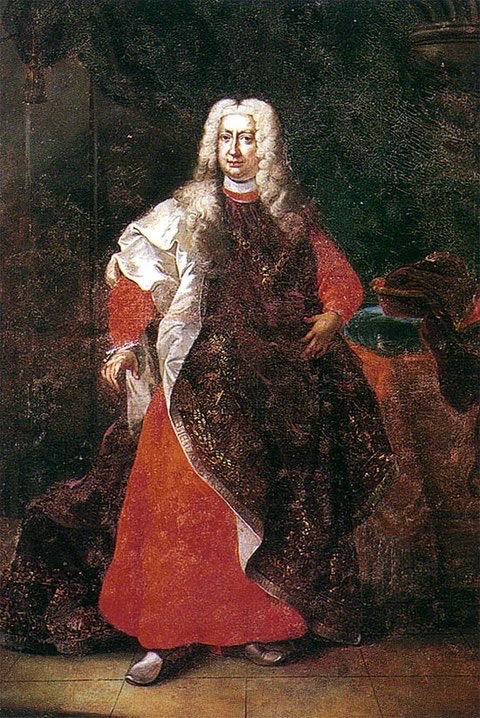
They were so passionate actually that prince Adam himself once hunted a deer with such immense antlers that his record was clogged in the 21st century only! Also those deer antlers have been preserved to this day in a very curious form: they are actually presented on the back side of the facade of Palais Schwarzenberg in Prague.
That’s extremely original, in my opinion! 🦌
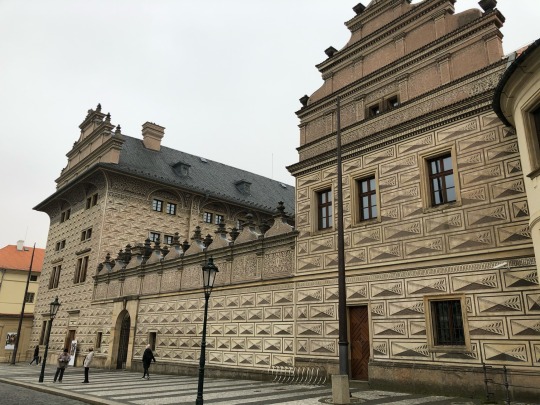


Unfortunately, the hunt became the main reason of prince Adam’s death as well: he was shot dead in 1732… by the emperor of Holy Roman Empire, Charles VI. There he is, the man, the legend *aggressive yelling*!
(Was it some kind of a special entertainment for some emperors in the past, I wonder? Can you say something about that, emperor Napoleon? :/)
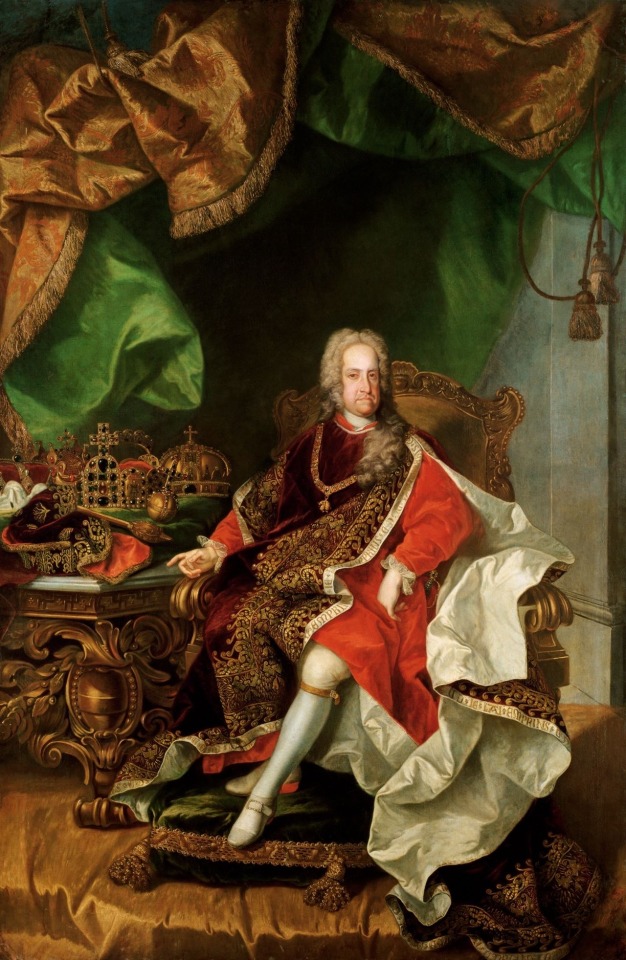
During that disastrous hunt, they happened to track down the exact same animal and were accidentally placed on the opposite sides of a field. When a deer jumped out of the bushes, emperor took a shot and hit prince in the stomach. Emperor’s physician tried to save his life but it didn’t work out. After 12 hours of agony prince Adam passed away... 😔
Feeling somewhat guilty, the emperor made his 10-year-old son a knight of the Order of the Golden Fleece as well. He grew to become one of empress Maria Theresa’s councillors and earned the rank of imperial prince for his House.
But the main question remains: does the life of a devoted nobleman equal to the most prestigious order in the Empire only…

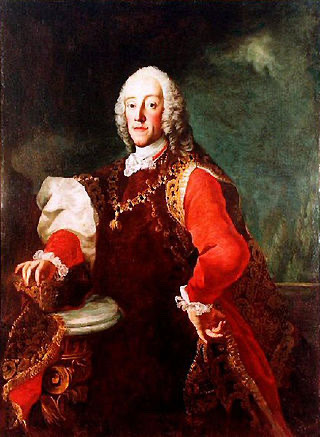
(As a small finishing touch I bring you today the portrait of Johann I zu Schwarzenberg, prince Joseph’s son and field marshal Karl’s father 🤲🇦🇹)
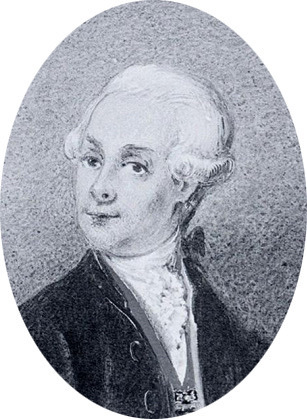
#schwarzenberg#house schwarzenberg#adam franz zu schwarzenberg#eleonore von schwarzenberg#charles vi habsburg#joseph i zu schwarzenberg#johann i zu schwarzenberg#holy roman empire#austrian history#18th century
14 notes
·
View notes
Text
What are the coalition guys up to in Christmas 2020? (Modern AU!Coalition commanders)
Inspired by my friend @histoireettralala I decided to make a version with the coalition bois, enjoy!
As we know, Bernadotte has decided to be burrito this Christmas and leave his wife and children playing with the snow on their own. But what about the others? Here are some things that they do:
Wellington, being a fan of parties, decided to throw his parties on Zoom, and get all the festive spirits. He and Lord Castlereagh had a great time ranting about the entire chaos that is going on in the UK (trust me, they shared the sentiments of people in the rest of Europe, facepalming over Brexit), also their shared grievances on America. Somehow, they decided to prank call the Cannigites—George Canning was unimpressed. I guess, it’s some Tier 3 fun going on (and Harriet Arbuthnot got the entire footage of this, with Blücher and Tsar Alexander as two of the witnesses).
Meanwhile for Nelson, despite being an “old boomer”, decided to have excessive partying and break all the quarantine rules. ((There are two types of people who live in Tier 3 regions during Christmas.
For Archduke Charles, he already got his anti-epileptic medication ready to survive Christmas. To avoid seizures, any kind of festive lights is forbidden within his household. Despite there were no Christmas markets this year due to an event ban, he and his family have a great time together. Of course, he also gave his kids got the best presents on Saint Nicholas’ Day.
Meanwhile, besides opening advent calendars, decorating the Christmas tree and giving out presents on Saint Nicholas’ Day, Karl Philipp zu Schwarzenberg already got the Christmas carp for his family. They have decided to release the fish into the river nearby on Christmas Eve.
Like all the other Austrians (*and Hungarians) and Germans, the Archduke and Schwarzenberg were found sitting at the couch watching “Sissi” during Christmas with their families.
Bonus: Empress Sisi herself was half-impressed, half-unimpressed on the movies (*well, Franz Joseph suggested this since they are now stuck together)—but heyyyy at least this is NOT the monstrosity of the books written by a certain American author who decided to make her having an affair with her BFF Gyula. By the way, when she’s left alone (finally), she had a nice zoom call with her friends and family (especially her little bro Gackl) just to rant about how she’s not able to go anywhere, despite she is still allowed to work out at home and go out for a walk every day under the pandemic.
Sadly, the Russians have their Christmas in January so they are not taking a break in December, but you will see a wild Barclay de Tolly blasting out “Auld Lang Syne” on New Year’s Eve (*and an annoyed and drunk Bagration)
That’s all I can think of, have a nice holiday! (And hopefully all the Christmas cards will arrive before Christmas🥺)
#coalition bois#featuring#a tired Sisi who just wanted to be left alone this Christmas#and a Franz Joseph who has been trying to keep everything together#also Lord Castlereagh being best bros with Atty#and an unamused Canning#arthur wellesley#duke of wellington#robert stewart#lord castlereagh#viscount castlereagh#george canning#regency bitches#sassy atty#horatio nelson#archduke Charles#karl philipp zu schwarzenberg#mikhail barclay de tolly#pyotr bagration#empress sisi#empress elisabeth#elisabeth of austria#elisabeth of bavaria#been fantasising Wellington and Castlereagh as ordinary teenage boys#the carp thing was a bohemian Christmas tradition and I hope I did not get it wrong😅#and watching Sissi movies is a modern Christmas tradition in the German-speaking world😄#btw got to expand my knowledge on French Christmas traditions so that I can write more of the marshal Christmas headcanons lol#Sisi would you like to trade lives with me in Sheffield? oh wait never mind I got an annoying neighbour#R.I.P. me I am stuck in Christmas ;-;#Franzi really tried hard to impress his wife on her birthday...
14 notes
·
View notes
Note
minor german catholic royalty/nobility are great value for absolutely batshit names. e.g. Johannes, Hereditary Prince of Schwarzenberg (born 1967) has the full name of Johannes Nepomucenus Andreas Heinrich Joseph Karl Ferdinand Johannes Evangelist die Heiligen Drei Könige Achaz Michael Maria. and then there's the surnames... "Oettingen-Oettingen and Oettingen-Wallerstein", "Schaffgotsch genannt Semperfrei von und zu Kynast und Greiffenstein". imagine filling out a form.
Damnit I was planning to call my child Johannes Nepomucenus Andreas Heinrich Joseph Karl Ferdinand Johannes Evangelist die Heiligen Drei Könige Achaz Michael Maria but now everyone will think I’m copying him!
#ok but does he have the first name johannes and the middle name johannes?#is he the royal version of moon moon?#ask#qvietbatpeople#deposed royal families
21 notes
·
View notes
Photo


Franz Joseph I or Francis Joseph I (Franz Joseph Karl; 18 August 1830 – 21 November 1916) was Emperor of Austria, King of Hungary, and monarch of many other states of the Austro-Hungarian Empire, from 2 December 1848 to his death.[1] From 1 May 1850 to 24 August 1866 he was also President of the German Confederation. He was the longest-reigning Emperor of Austria and King of Hungary, as well as the third-longest-reigning monarch of any country in European history, after Louis XIV of France and Johann II of Liechtenstein.[2]
In December 1848, Emperor Ferdinand abdicated the throne at Olomouc, as part of Minister President Felix zu Schwarzenberg's plan to end the Revolutions of 1848 in Hungary. This allowed Ferdinand's nephew Franz Joseph to accede to the throne. Largely considered to be a reactionary, Franz Joseph spent his early reign resisting constitutionalism in his domains. The Austrian Empire was forced to cede its influence over Tuscany and most of its claim to Lombardy–Venetia to the Kingdom of Piedmont-Sardinia, following the Second Italian War of Independence in 1859 and the Third Italian War of Independence in 1866. Although Franz Joseph ceded no territory to the Kingdom of Prussia after the Austrian defeat in the Austro-Prussian War, the Peace of Prague (23 August 1866) settled the German question in favour of Prussia, which prevented the Unification of Germany from occurring under the House of Habsburg.[3]
Franz Joseph was troubled by nationalism during his entire reign. He concluded the Austro-Hungarian Compromise of 1867, which granted greater autonomy to Hungary and transformed the Austrian Empire into the Dual Monarchy of Austria-Hungary. He ruled peacefully for the next 45 years, but personally suffered the tragedies of the execution of his brother, the Emperor Maximilian of Mexico in 1867, the suicide of his only son and heir, Crown Prince Rudolf, in 1889, and the assassination of his wife, Empress Elisabeth, in 1898.
After the Austro-Prussian War, Austria-Hungary turned its attention to the Balkans, which was a hotspot of international tension because of conflicting interests with the Russian Empire. The Bosnian Crisis was a result of Franz Joseph's annexation of Bosnia and Herzegovina in 1908, which had been occupied by his troops since the Congress of Berlin (1878).
On 28 June 1914, the assassination of his nephew, Archduke Franz Ferdinand, in Sarajevo resulted in Austria-Hungary's declaration of war against the Kingdom of Serbia, which was Russia's ally. That activated a system of alliances which resulted in World War I.
Franz Joseph died on 21 November 1916, after ruling his domains for almost 68 years as one of the longest-reigning monarchs in modern history. He was succeeded by his grandnephew Charles.
https://en.wikipedia.org/wiki/Franz_Joseph_I_of_Austria
0 notes
Photo


Franz Joseph I or Francis Joseph I (18 August 1830 – 21 November 1916) was Emperor of Austria and King of Hungary, King of Bohemia and many others (see grand title of the Emperor of Austria) from 2 December 1848 to his death. From 1 May 1850 to 24 August 1866 he was also President of the German Confederation. He was the longest-reigning Emperor of Austria and King of Hungary, as well as the third-longest-reigning monarch of any country in European history, after Louis XIV of France and Johann II of Liechtenstein.In December 1848, Emperor Ferdinand abdicated the throne at Olomouc, as part of Ministerpräsident Felix zu Schwarzenberg's plan to end the Revolutions of 1848 in Hungary. This allowed Ferdinand's nephew Franz Joseph to accede to the throne. Largely considered to be a reactionary, Franz Joseph spent his early reign resisting constitutionalism in his domains. The Austrian Empire was forced to cede its influence over Tuscany and most of its claim to Lombardy–Venetia to the Kingdom of Piedmont-Sardinia, following the Second Italian War of Independence in 1859 and the Third Italian War of Independence in 1866. Although Franz Joseph ceded no territory to the Kingdom of Prussia after the Austrian defeat in the Austro-Prussian War, the Peace of Prague (23 August 1866) settled the German question in favour of Prussia, which prevented the Unification of Germany from occurring under the House of HabsburgFranz Joseph was troubled by nationalism during his entire reign. He concluded the Austro-Hungarian Compromise of 1867, which granted greater autonomy to Hungary, which transformed the Austrian Empire into the Austro-Hungarian Empire, under his dual monarchy. His domains were then ruled peacefully for the next 45 years, but Franz Joseph personally suffered the tragedies of the execution of his brother Maximilian in 1867, the suicide of his only son and heir, Crown Prince Rudolf, in 1889, and the assassination of his wife, Empress Elisabeth, in 1898.After the Austro-Prussian War, Austria-Hungary turned its attention to the Balkans, which was a hotspot of international tension because of conflicting interests with the Russian Empire. The Bosnian Crisis was a result of Franz Joseph's annexation of Bosnia and Herzegovina in 1908, which had been occupied by his troops since the Congress of Berlin (1878).On 28 June 1914, the assassination of his nephew, Archduke Franz Ferdinand, in Sarajevo resulted in Austria-Hungary's declaration of war against the Kingdom of Serbia, which was Russia's ally. That activated a system of alliances which resulted in World War I.Franz Joseph died on 21 November 1916, after ruling his domains for almost 68 years. He was succeeded by his grandnephew Charles.
#emperor franz joseph#franz joseph i#austria hungary#ww1#Austrian Empire#austrian royalty#the invincible army
0 notes
Text
May I ask you, dear gentlemen and gentlewomen, what time is it? I humbly believe that it’s a meme time!
Once again trying my best in the field of some incredibly local history-related jokes and puns realised with the help of memes which sometimes seem old as time itself… Fortunately, we constantly speak about time, space and particular historical epoch over here, thus I proclaim the notion “outdated meme” a social construct. 👍
Aaaand proudly present to you this notorious composition called “The Austrian Chancellor who came to save the imperial day from the God-knows-where-in-the-Rhein-region and the 33 Bohemian noblemen (with the intrusion of one Moravian “fonctionnaire”) who accompanied him on his thorny life-path”!
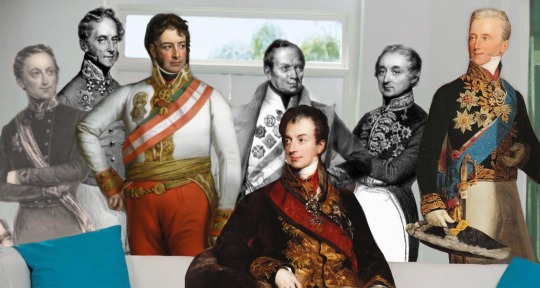
Of course, 33 person in one picture would be a little bit too much. That’s why I took the creative liberty to pick only the most famous and influential ones whom I’m going to name all at once (with the exception of dear Fürst Karl, for sure, cause his emersion will probably start causing headaches for everyone who still checks this God forsaken blog soon…)!
Let’s start with two wonderful people standing proudly behind Schwarzenberg’s back as they were his favourite adjutants during the Napoleonic campaigns of 1812-1814 and owe him a lot with regards to their careers in the Austrian military ranks. The first one is Karl Johann Nepomuk Gabriel Graf Clam-Martinez (count Karl Clam-Martinez, in short), a wonderful soldier and even more brilliant administrator who will actively help Metternich in his rivalry with another exceptional gentlemen featuring in this meme which took place in the late 1830s (like he suddenly died in 1840).
Cool story alert! In April 1814 Clam was a member of the group of allied generals who accompanied Napoleon himself on his journey to Elba and saved the emperor from certain humiliating experience few times. Napoleon was truly grateful to him and treated him well during those memorable times. 🤲
The second one is non other than Alfred Candidus Ferdinand Fürst zu Windisch-Grätz (prince Alfred zu Windish-Grätz, in short), a flamboyant, hot-headed, very straight-forwards military man (future field-marshal) who - according to the contemporaries - managed to steal the hearts of half of the renown European beauties, most notably of Wilhelmina, duchess of Sagan. So, yeah, he actually was Metternich’s adversary №1 for a while, when it came to the sphere of scandalous love affairs, and let me tell you all, it was a sh*t show I still can’t comprehend fully because it was too much. Even for such an eccentric person as Metternich… ☠️
(Actually! Actually, both Clam and Windisch-Grätz were les amants of the two most renown sisters of Sagan - Wilhelmina, being the eldest, and Dorothea, being the youngest, - during the Congress of Vienna. Basically at the same time as those stunning women drove crazy Metternich and Talleyrand respectively. I can see that hilarious picture clearly: two diplomats practically dying of their love towards sisters of Sagan; two sisters of Sagan cheerfully celebrating the New 1815 year together with two young distinguished Austrian officers of Czech origin; meanwhile Schwarzenberg, the president of Hofkriegsrath already, just sits in his Kriegsgebäude, listens to the rumours about his ✨good boiz✨ and sighs resignedly…)
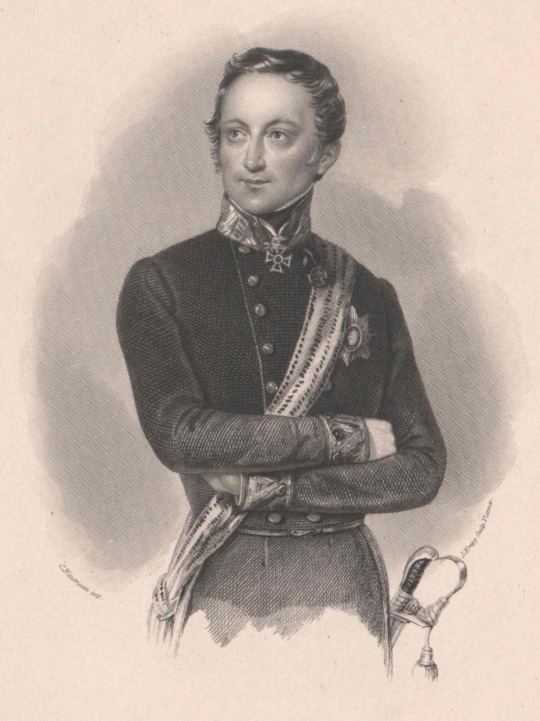
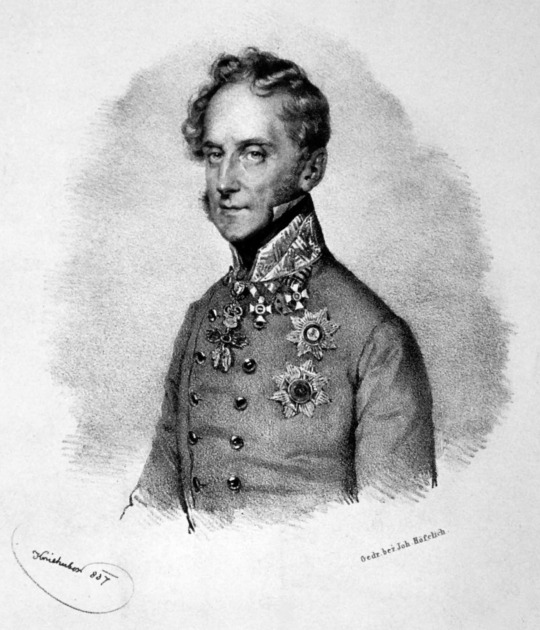
Well, that was fun! Passing on to count Radetzky…
…Comes a sudden revelation that I won’t speak out a lot about Joseph Wenzel Anton Franz Karl Graf Radetzky von Radetz (count Joseph Radetzky, in short) simply because it’s him! He probably is the most well-known herr out of the whole company - Metternich’s close friend, whom Klemens saved from the total oblivion after the war of 1809, the head-of-stuff at Schwarzenberg’s times, future president of Hofkriegsrath as well and the “father of the nation”, of course (does a question “what is the second-to-first «titular» nation in the Habsburg’s monarchy after the Austrians themselves” truly appear after that claim, I wonder)!
*also, like, Windish-Grätz and Radetzky were the 1848s main repressive force in the empire and the only people who truly mourned Metternich’s resignation and exile - what a turn of events, for Alfred especially!*
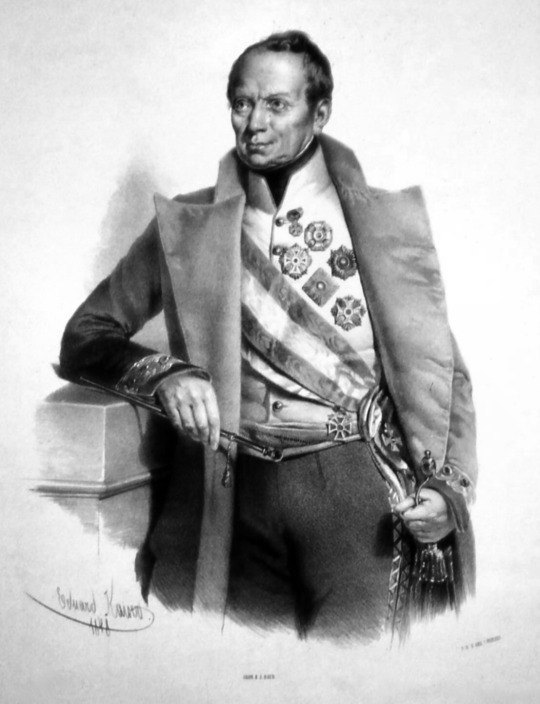
Now we come to the uncharted territory almost.
This wonderful person is… Karl Friedrich von Kübeck, Freiherr von Kübau. He sounds quite simple, ordinary even, you might say, however his origin story is a miracle. This man was a son of a tailor from Moravia (it’s like Bohemia is the western part of modern-days Czech Republic and Moravia is the eastern part of the country) who rose to the position of hofrat and obtained a barony as a reward for his excellent service. He joined Metternich’s opposition to the last character who will appear in our miraculous story in the late 1830-1840s as he understood everyone’s weaknesses very well and still saw in Metternich, an incredibly experienced official at the time, a lot of potential.
The man of his social background, he understood the needs of the country better than anyone else, yet he was unsuccessful in his efforts of reforming the monarchy slowly but surely without any need for an internal bloodshed. And that was a real tragedy, since even Metternich himself tried to adapt the bullky machinery of the Austrian empire to the certain notions of time still in the 1820s… Even Metternich, one the most famous conservators of the post-Napoleonic Europe.
I guess, that circumstance speaks all for itself. 😔
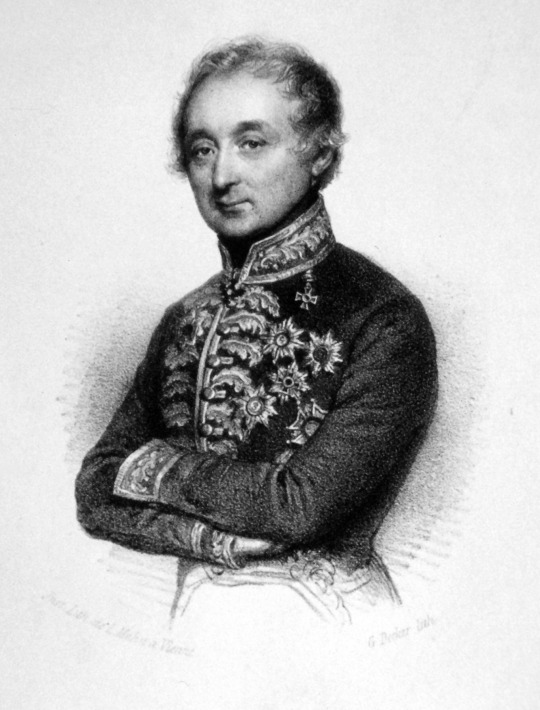
Thus, we arrive to the glorious conclusion of this extensive memology and it has the magnetic face of Franz Anton Graf von Kolowrat-Liebsteinsky (count Franz Kolowrat-Liebsteinsky). He deserves to crown our noble list of Bohemian aristocrats, since he became the actual governor of the region in the year 1809! He also was elevated to lead the Austrian State Council responsible for the Interior and Finances in 1826. 🇨🇿
The most important period in his life came with the death of the emperor Franz II and the accession to the throne of his poor son Ferdinand who had such bad health issues that he needed a Regency council to aid him in his reign. Who tried to claim all the responsibilities to himself only? Of course, it was our dear Klemens! Metternich actually waged very intense battles against Kolowrat since his appointment as the minister of the interior. And after the creation of the Regency council their rivalry could be described as “two delicate, aristocratic from the top of their silver-haired heads to the tip of their sleek fingers, old queens fighting constantly throughout the whole damned Vormärz”. 🙄
In the end, we can say with confidence, that count Kolowrat emerged victorious from the struggle: the Revolution of 1848 made an exile out of the damned Mephistopheles Metternich, meanwhile Kolowrat became the first Minister-President of the renewing Habsburg’s monarchy.
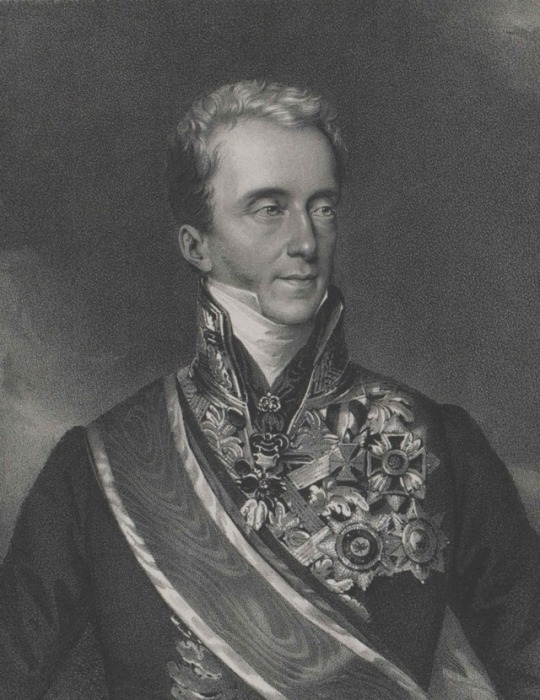
~~~~~~~
Well. That was an incredible journey half a century long, for sure. 👁👁
Very proud of marrying successively all the puns with the factual information I wanted to share about this incredible company of Austrian men who were connected to each other so gracefully and so closely. 🇦🇹
Hope you’ll like it as well, dear readers! It’s always my pleasure. 💗
Bis zum nächsten Mal~
#history meme#klemens von metternich#karl zu schwarzenberg#karl von clam-martinez#alfred zu windisch-grätz#joseph radetzky#karl von kübeck#franz von kolowrat-liebsteinsky#napoleonic era#napoleonic wars#austrian empire#austrian nobility#19th century
18 notes
·
View notes
Text
So, I want to thank you so much, @joachimnapoleon for showing your interest in Schwarzenberg’s coat of arms and @josefavomjaaga for your contribution! I actually thought that this particular conversation could be closed but then, unfortunately, came up with some additional thoughts on the matter! 😅
As @josefavomjaaga stated, there was a man in the Schwarzenberg’s family thanks to whom the Turk’s head with a raven pecking out his eye was added to their coat of arms.
And there is this wonderful monument in a modern-day Györ, depicting two military commanders who conquered the same fortress which was held by Turks in 1599 - Adolf zu Schwarzenberg and Miklós Pálffy, Hungarian military man and politician who proved himself in the first wars against Turks as well. ⚔️
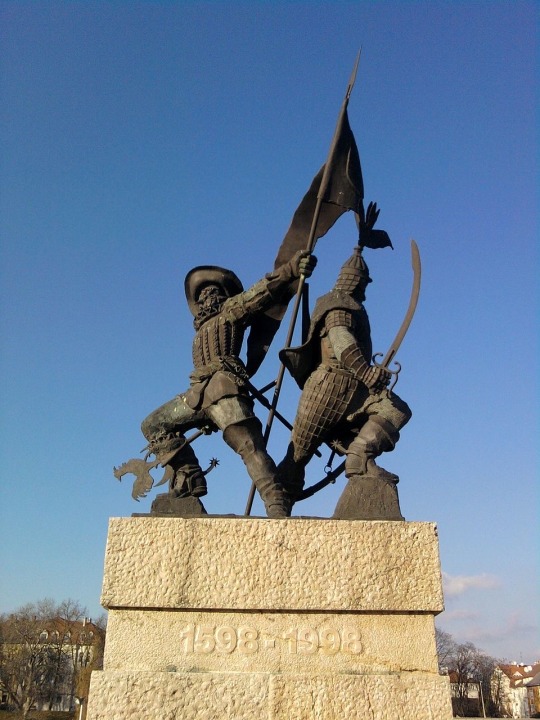
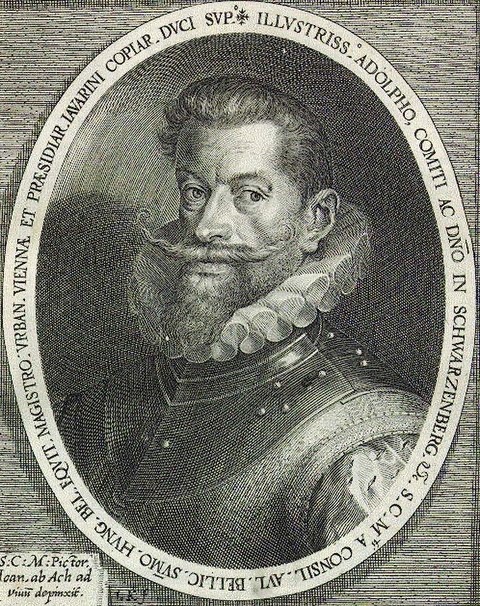

(Now that I think about it, I suddenly remembered the context in which I heard about the exact same Hungarian family within the Napoleonic era: when Metternich’s first marriage with a grand-daughter of renowned Imperial chancellor Kaunitz, Eleonora, was arranged by his mother in 1795, she had to oppose the same matrimonial interest which came from an influential princess Pálffy (nee countess Coloredo) as this woman belonged to the Vienna circle of the most powerful aristocratic families in the Holy Roman Empire. Understandably, nobody wanted to let Eleonora marry some barely-known aristocrat who recently came from Rhein almost without any possessions! But in the end Clemens had his charms and beauty which helped him win Eleonora’s heart over any other more “suitable” candidate from Vienna society. 💅)
Buuut enough about that, let’s get back to House of Schwarzenberg!
That’s how the first transformation of Schwarzenberg’s coat of arms looked like, blue and silver-striped shield being the legacy of the Seinsheim origin:


At those times Schwarzenbergs were counts of the Empire and they remained so until the mid-17th century when Johann Adolf I. zu Schwarzenberg (1641–1670) finally received a princely title.
The last major change in the state of a House came in the beginning of the 19th century with the birth of two male heirs who lived long enough to fulfil the will of theirs grand-grand-grand-father, prince Ferdinand (1652-1703).
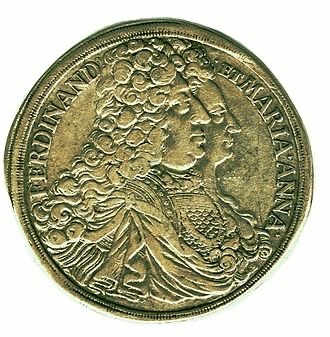
His will essentially proclaimed the division of the house into two princely-titled lines (majorates).
Thus, the senior branch was represented by Joseph II zu Schwarzenberg, the eldest brother of the field marshal renowned for his participation in the Napoleonic wars, and the cadet branch was established by field marshal Karl Philipp zu Schwarzenberg himself. The senior branch held not only Palais Schwarzenberg in Vienna, but also the Dominions of Scheinfeld, Krumlov, Frauenberg and Murau, while the cadet branch resided in Orlík and held few other residences bought by Karl himself.
(Nevertheless, Karl and his wife, Maria Anna von Hohenfeld, still visited Vienna on regular basis. For example, all of their three sons were born in Vienna, most likely in the same Palais Schwarzenberg which already belonged to Karl’s older brother).
To sum it all up, here are their magnificent princely coats of arms! They look almost identical except for the upper part. It probably represents Karl’s military service for the Habsburgs.
There is also a small part with a silver tower on a black hill to commemorate the castle Schwarzenberg in Bavaria which is where it all started. 🏰


And here are the portraits of the two brothers, Joseph (born in 1769) and Karl (born in 1771).
As far as I can tell, they were very close to each other since they grew together and were educated by the same scholars until Karl started his military service in 1786 and then in 1788 went to the war against Turks…
Nice way to honour the memory of his ancestor Adolf, isn’t it? :)
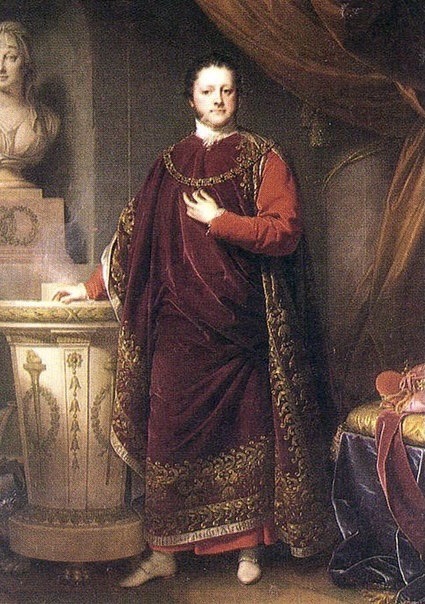
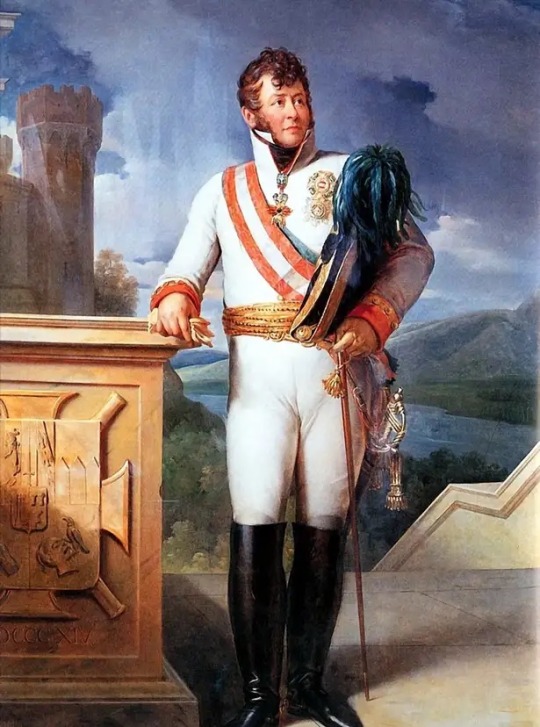
#napoleonic era#napoleonic wars#schwarzenberg#house schwarzenberg#adolf zu schwarzenberg#joseph II zu schwarzenberg#karl zu schwarzenberg#austrian empire
16 notes
·
View notes
Text
After all the ball resumes! 🥂
.
.
.
Ahem, my bad, the Vienna Congress will be opened next year only!
Until then we’re stuck with an incredibly important meeting of prominent people which will eventually lead to an extraordinary outcome (especially if we remember all the past wars and their results which were rather… unfavourable for all the previous Coalitions and their paticipants).
And that’s why here comes
Part 2 of the main characters in the Kraft’s painting “Battle of Leipzig”
Let’s continue our small-talk with another representative of the general-headquarters, the most important one for sure - count Joseph Radetzky von Radetz, the chief-of-staff in the Bohemian army led by Schwarzenberg himself. Amongst his colleagues in the headquarters he probably had the most influence on the decisions made by Schwarzenberg and three allied monarchs themselves.
His placement in the painting illustrates this idea quite well! Even though at first sight he seems to be somewhat “lost” among the officers surrounding him, Radetzky is actually in the heart of a crowd probably listening to Gneisenau’s thoughts on the current state of affairs. 🗣
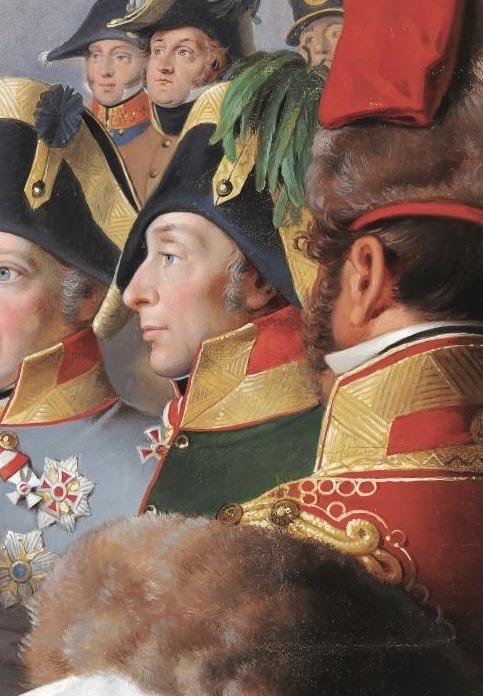

I also want to give another illustrative example of him wearing dark-green which, in my opinion, suits him very well. :)
It’s a much later artwork (the second half of the 19th century) created by another talented Austrian painter Carl von Blaas - a series of panels in the Ruhmeshalle (the Hall of Fame) which is located in the Museum of Military History in Vienna. There, on the walls from floor to ceiling are depicted the most important military victories in the history of Austria. This one in particular shows us the aftermath of a battle: kaiser Franz decorates the commander-in-chief of allied forces - Karl zu Schwarzenberg - with the Grand Cross of the Order of Maria Theresa. Right behind him stands Radetzky with his arms crossed on his chest.
Soooo serious and solemn! ✨
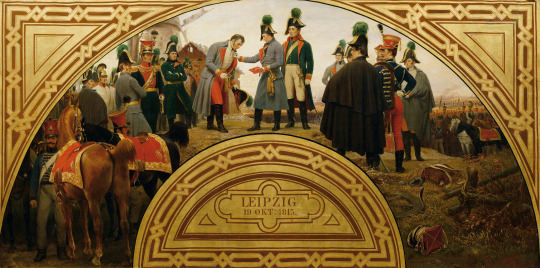
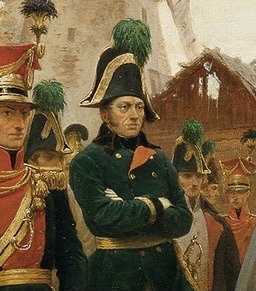
(One more off top since I simply can’t help myself… Like, OMG, Schwarzenberg looks so blissful in this picture. It’s literally heartwarming! 🤲🤲🤲)
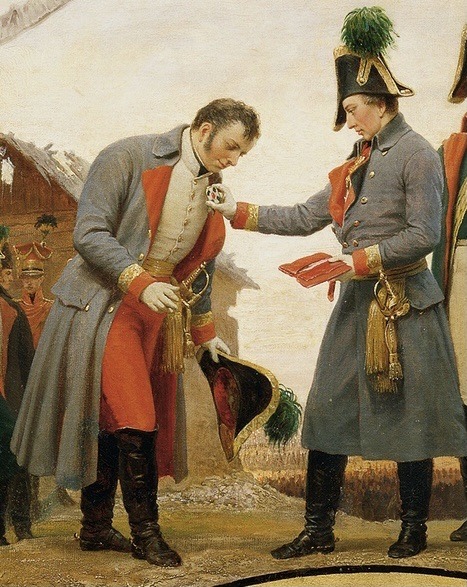
All in all, there’re many representatives from different European countries making up the crowd behind three monarchs’ backs. I’m sure there must be some military men from those German states which after all decided to join the allied forces but I’m not competent enough to identify all of them… (Yet, hopefully! 😅)
But I can say for sure that at least two more men in the crowd (who are somewhat hiding behind other’s backs) are of a particular interest.
The first one has such striking appearance that it’s almost impossible to confuse him with anyone else. Say hello to Adam Albert von Neipperg, a military men, a diplomat and… a future husband of archduchess Marie Louise as she was never allowed to reunite with Napoleon after the victory of the allies.
What a surprise to see him out there!
By the way, nice eyepatch, my man. ✨
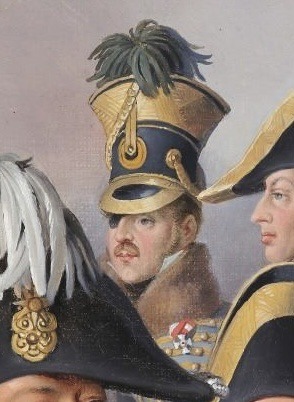
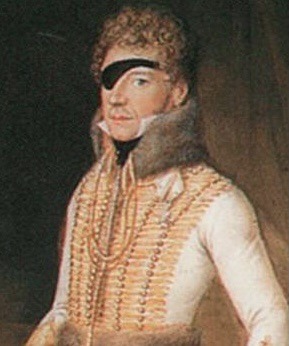
And next to him is Maximilian von Merveldt, a general who was unfortunate enough to be captured by Napoleon’s men during the first day of a battle…
Oops, that’s quite unpleasant. :(
After that he had to deliver Napoleon’s peace offering which was immediately rejected by allied monarchs since it was only the 16th of October and much more reinforcements were on their way to the battlefield. ✊

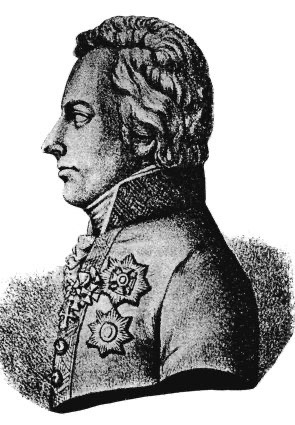
To be continued even 🔜 er
#napoleonic era#napoleonic wars#battle of leipzig#völkerschlacht bei leipzig#joseph radetzky#adam von neipperg#maximilian von merveldt#19th century
22 notes
·
View notes
Photo

Franz Joseph I or Francis Joseph I (Franz Joseph Karl; 18 August 1830 – 21 November 1916) was Emperor of Austria, King of Hungary, and monarch of other states in the Austro-Hungarian Empire, from 2 December 1848 to his death.[1] From 1 May 1850 to 24 August 1866 he was also President of the German Confederation. He was the longest-reigning Emperor of Austria and King of Hungary, as well as the third-longest-reigning monarch of any country in European history, after Louis XIV of France and Johann II of Liechtenstein.[2]
In December 1848, Emperor Ferdinand abdicated the throne at Olomouc, as part of Minister-president Felix zu Schwarzenberg's plan to end the Revolutions of 1848 in Hungary. This allowed Ferdinand's nephew Franz Joseph to accede to the throne. Largely considered to be a reactionary, Franz Joseph spent his early reign resisting constitutionalism in his domains. The Austrian Empire was forced to cede its influence over Tuscany and most of its claim to Lombardy–Venetia to the Kingdom of Piedmont-Sardinia, following the Second Italian War of Independence in 1859 and the Third Italian War of Independence in 1866. Although Franz Joseph ceded no territory to the Kingdom of Prussia after the Austrian defeat in the Austro-Prussian War, the Peace of Prague (23 August 1866) settled the German question in favour of Prussia, which prevented the Unification of Germany from occurring under the House of Habsburg.[3]
Franz Joseph was troubled by nationalism during his entire reign. He concluded the Austro-Hungarian Compromise of 1867, which granted greater autonomy to Hungary and transformed the Austrian Empire into the Austro-Hungarian Empire, under his dual monarchy. His domains were then ruled peacefully for the next 45 years, but Franz Joseph personally suffered the tragedies of the execution of his brother Maximilian in 1867, the suicide of his only son and heir, Crown Prince Rudolf, in 1889, and the assassination of his wife, Empress Elisabeth, in 1898.
After the Austro-Prussian War, Austria-Hungary turned its attention to the Balkans, which was a hotspot of international tension because of conflicting interests with the Russian Empire. The Bosnian Crisis was a result of Franz Joseph's annexation of Bosnia and Herzegovina in 1908, which had been occupied by his troops since the Congress of Berlin (1878).
On 28 June 1914, the assassination of his nephew, Archduke Franz Ferdinand, in Sarajevo resulted in Austria-Hungary's declaration of war against the Kingdom of Serbia, which was Russia's ally. That activated a system of alliances which resulted in World War I.
Franz Joseph died on 21 November 1916, after ruling his domains for almost 68 years. He was succeeded by his grandnephew Charles.
https://en.wikipedia.org/wiki/Franz_Joseph_I_of_Austria
0 notes